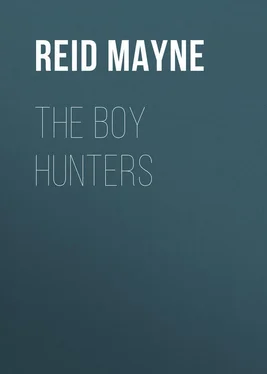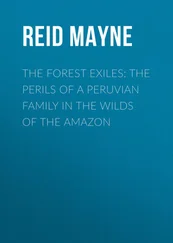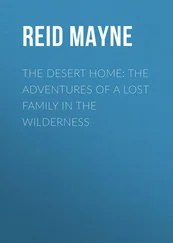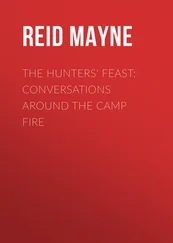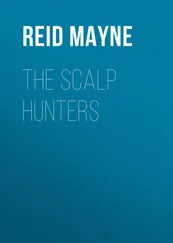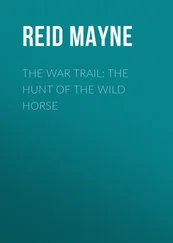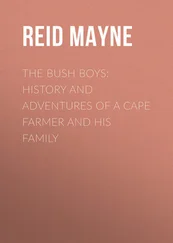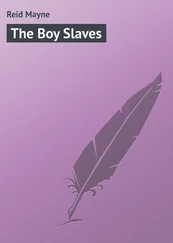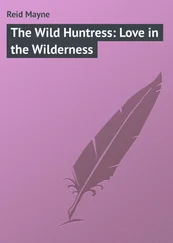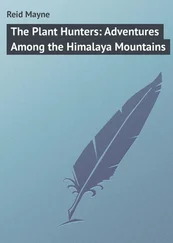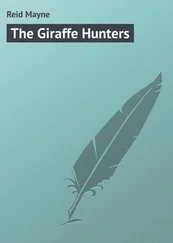Mayne Reid - The Boy Hunters
Здесь есть возможность читать онлайн «Mayne Reid - The Boy Hunters» — ознакомительный отрывок электронной книги совершенно бесплатно, а после прочтения отрывка купить полную версию. В некоторых случаях можно слушать аудио, скачать через торрент в формате fb2 и присутствует краткое содержание. Жанр: literature_19, foreign_antique, foreign_prose, на английском языке. Описание произведения, (предисловие) а так же отзывы посетителей доступны на портале библиотеки ЛибКат.
- Название:The Boy Hunters
- Автор:
- Жанр:
- Год:неизвестен
- ISBN:нет данных
- Рейтинг книги:3 / 5. Голосов: 1
-
Избранное:Добавить в избранное
- Отзывы:
-
Ваша оценка:
- 60
- 1
- 2
- 3
- 4
- 5
The Boy Hunters: краткое содержание, описание и аннотация
Предлагаем к чтению аннотацию, описание, краткое содержание или предисловие (зависит от того, что написал сам автор книги «The Boy Hunters»). Если вы не нашли необходимую информацию о книге — напишите в комментариях, мы постараемся отыскать её.
The Boy Hunters — читать онлайн ознакомительный отрывок
Ниже представлен текст книги, разбитый по страницам. Система сохранения места последней прочитанной страницы, позволяет с удобством читать онлайн бесплатно книгу «The Boy Hunters», без необходимости каждый раз заново искать на чём Вы остановились. Поставьте закладку, и сможете в любой момент перейти на страницу, на которой закончили чтение.
Интервал:
Закладка:
“Yes, yes,” replied François; “the Spanish moss.”
“Yes, Spanish moss, as we call it here, or old-man’s-beard moss, as they name it in other parts. It is no moss, however, but a regular flowering plant, although a strange one. Now, according to these philosophic naturalists, that long, stringy, silvery creeper, that looks very like an old man’s beard, is of the same family of plants as the pineapple!”
“Ha! ha! ha!” roared François; “Spanish moss the same as a pineapple plant! Why, they are no more like than my hat is to the steeple of a church.”
“They are unlike,” continued Lucien, “in every respect – in appearance, in properties, and uses; and yet, were you to consult the dry books of the closet-naturalists, you would learn that this Spanish moss ( Tillandsia ) was of a certain family of plants, and a few particulars of that sort, and that is all you would learn about it. Now what is the value of such a knowledge? What is it to compare with a knowledge of the appearance, the structure, and character of the plant – of its properties and the ends for which nature designed it – of its uses to the birds and beasts around – of its uses to man – how it makes his mattress to sleep on, stuffs his sofas, and saddles, and chairs equal to the best horse-hair, and would even feed his horse in case of a pinch? In my opinion, these are the facts worth knowing; and who are the men who publish such facts to the world? Not your closet-naturalists, I fancy.”
“True, very true, brother; but let us not vex ourselves about such things; go on, and tell us what you know of the crocodiles.”
“Well, then,” said Lucien, returning to his natural tone and manner, “as I have already said, the crocodiles are divided into three genera — crocodiles , gavials , and alligators . It is Baron Cuvier who has made this distinction; and he rests it more upon the shape of the head and the set of the teeth, than upon any real difference in the appearance or habits of these animals. The crocodiles have long, pointed, narrow snouts, and a large tooth in each side of the lower jaw, which, when the mouth shuts, passes into a groove in the upper. ‘These are the true crocodiles,’ says Monsieur Cuvier. The gavials have also long, pointed, narrow, roundish snouts, but their teeth are nearly equal-sized and even. The alligators, on the contrary, have broad pike-shaped noses, with teeth very unequal, and one large one on each side of the lower jaw, that, when the mouth shuts, passes – not into a groove as with the crocodile – but, into a hole or socket in the upper jaw. These are Monsieur Cuvier’s distinctions; which he takes a world of pains to point out and prove. He might, in my opinion, have spared himself the trouble, as there are so few varieties of the animal in existence, that they might have been treated of with greater simplicity as so many species of the genus ‘crocodile.’
“Of the true crocodiles there are five species known. Four of these are found in the rivers of Africa, while the fifth is an inhabitant of the West Indies and South America. The gavial is found in Asia – particularly in the Ganges and other Indian rivers, and is the crocodile of those parts. The alligator belongs to America, where it is distributed extensively both in North and South America. In the Spanish parts it is called ‘caïman,’ and there are two species well-known, viz the spectacled caïman of Guiana, and the alligator of the Mississippi. No doubt, when the great rivers of South America have been properly explored, it will come to light, that there are other varieties than these. I have heard of a species that inhabits the Lake Valencia in Venezuela, and which differs from both the American species mentioned. It is smaller than either, and is much sought after by the Indians for its flesh, which these people eat, and of which they are particularly fond. It is probable, too, that new species of crocodiles may yet be found in Africa and the islands of the Indian Ocean.
“Now I think it is a well-ascertained fact, that all these varieties of the crocodile family have pretty much the same habits, – differing only where such difference might be expected by reason of climate, food, or other circumstances. What I shall tell you of the alligator, then, will apply in a general way to all his scaly cousins. You know his colour, – dusky-brown above, and dirty yellowish-white underneath. You know that he is covered all over with scales, and you see that on his back these scales rise into protuberances like little pyramids, and that a row of them along the upper edge of his tail give it a notched, saw-like appearance. You notice that the tail is flattened vertically, and not like the tail of the beaver, which is compressed horizontally. You observe that the legs are short and very muscular – that there are five toes on the fore-feet, slightly webbed or palmated, and four on the hind-feet much longer and much more webbed. You notice that his head is somewhat like that of a pike, that the nostrils are near the end of the snout, the eyes prominent, and the opening of the ears just behind them. His eyes have dark pupils, with a lemon-coloured iris; and the pupils are not round, as in the eye of a man, but of an oval shape, something like those of a goat.
“All these things you may observe by looking at an alligator. But there are some things about the structure of the animal which are peculiar, and which may not strike you so readily. You observe that his jaws open far back – even beyond the ears – where they are hinged or articulated into each other. Now this is a peculiar formation, and the effect is, that when the alligator opens his mouth, his neck becomes somewhat bent upwards, giving him the appearance of having moved the upper instead of the under jaw.”
“Why I have often heard that that was so,” remarked François.
“Many have thought so, and said so, since the time of Herodotus, who first propagated this absurd idea. It is not the fact, however. It is the lower jaw that moves, as in other vertebrated animals; but the appearance I have described leads to the mistake that has been made by careless observers. There is another point worth speaking of. The opening of the alligator’s ear is guarded by a pair of lips, which he closes the moment he goes under water. His nostrils, too, are protected by valves, which he can also close at will. There is also a peculiarity about his vertebrae. These are so jointed to each other, that he cannot turn without describing a circle with his body. He can move his head but slightly to one side or the other; and this is a fortunate circumstance, if not for him, at least for his enemies. Were he able to turn short round, or twist himself about, as serpents do, he would be a most dangerous creature to encounter. As it is, the great length of his body, combined with the shortness of his legs and the impossibility of his getting round quickly, renders him an easy antagonist on land, provided you keep out of reach of his great jaws, and beyond the sweep of his powerful tail. This last is his true weapon of offence or defence; and as it is not restrained by any vertebrae, he can use it with such effect as to knock the breath out of a man with one single flap. Many of the habits of the alligator are known to you. How the female lays eggs as big as those of a goose, and buries them in the sand, where they are hatched by the heat of the sun. Sometimes she cannot find a sandbank to suit her purpose. She then raises a circular platform of mud mixed with grass and sticks. Upon this she deposits a layer of eggs, and covers them over with several inches of mud and grass. She then lays a fresh tier of eggs, covering these also with mud, and so on until she has laid her whole hatching, which often amounts to nearly two hundred eggs, of a dirty greenish-white colour. In the end she covers all up with mud, plastering it with her tail until it assumes the appearance of a mud oven or beaver-house. All these pains she takes to protect her eggs from raccoons and turtles, as well as vultures and other birds, that are very fond of them. She haunts near the spot while the eggs are hatching, so as to keep off these enemies. When the young are out, her first care is to get them to the water out of the way of such dangers. This seems to be their first instinct, too; for no sooner are they free from the shell than they are seen scuttling off in that direction, or following their mother, many of them having climbed upon her back and shoulders.”
Читать дальшеИнтервал:
Закладка:
Похожие книги на «The Boy Hunters»
Представляем Вашему вниманию похожие книги на «The Boy Hunters» списком для выбора. Мы отобрали схожую по названию и смыслу литературу в надежде предоставить читателям больше вариантов отыскать новые, интересные, ещё непрочитанные произведения.
Обсуждение, отзывы о книге «The Boy Hunters» и просто собственные мнения читателей. Оставьте ваши комментарии, напишите, что Вы думаете о произведении, его смысле или главных героях. Укажите что конкретно понравилось, а что нет, и почему Вы так считаете.
